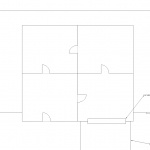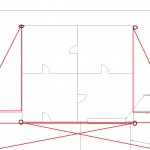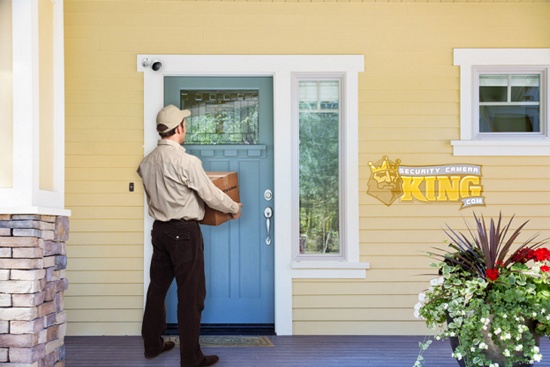So you know that you want to install a security camera system. You have bought the best security cameras to accomplish your video surveillance goals. Naturally, the next problem you will need to tackle is where to put security cameras for optimum placements.
How should you mount the surveillance cameras for the best angles? Where should you mount them to get the best view? Is every camera different or does this apply to them all? Is it better to choose dome cameras or bullet cameras?
These are all fairly common questions many people ask of professional security camera installers. We’ll answer where to put security cameras and explore the other questions to help new owners and even some seasoned users below. Hopefully, by the end, you will feel more confident in your knowledge about where to put security cameras and assured in your choices.
Where to Mount Security Cameras
First, let’s break down just how and where to mount your cameras. It’s important to note that everything single environment and setting is different. There is no one-size-fits-all answer that covers every possible layout or scenario. However, there are some general factors that apply to most common settings that should prove to be helpful.
Let’s go over where to put security cameras for residential surveillance systems to begin. These placements are fairly simple to understand and achieve. When placing a security camera to monitor a doorway, the camera placement should be within about 5 feet for utilizing facial identification. On the outer parts of the house, the most ideal placements for home security cameras are on the corners with views that intersect.
Placing the cameras in this way allows for double coverage in vulnerable areas, such as individuals approaching from a back alley, avenue, and common foot traffic traveling on or to doors, windows, driveways, and sidewalks. This also provides a contingency plan for such scenarios as a car in the driveway blocking the field of view from the front walkway for one of the outdoor cameras.
Below is an example outlining where to put security cameras in this fashion using a common house design.


As you can see, by overlapping the camera views, the cameras have double coverage over the garage and front door. It’s also important to note that the majority of fixed lens cameras have much wider viewing angles than the simple illustration presents.
License plate capture cameras require much more specific placement. A license plate capture camera will need to be three feet from the ground and within 20 feet of the thoroughfare. It’s also best to place license plate cameras to record slower moving traffic or traffic stops.
For more information about where to put license plate capture security cameras, read our previous article tackling exactly this topic here: Setup License Plate Capture Camera.
Camera Viewing Angles
Next, let’s cover where to put security cameras to achieve the proper viewing angle. Again, every scenario and setting varies greatly and depends on how much area you are hoping to cover. Additionally, resolution places a big role.
The higher up and further back you place the cameras, the more coverage you will be able to get. However, if you have low-resolution cameras then doing this will compromise the quality of your footage, potentially making it unusable.
The general rule of thumb for where to put security cameras is to try to obtain maximum coverage with minimum effort. In other words, you should angle or position the cameras to view only the edge of a wall or fence line.
Doing so will permit you to get the most out of each of the cameras and could even allow you to reduce the total number of security cameras you will need overall. Another factor to keep in mind is to try and make sure the camera placements are not easily within arm’s reach. However, the next point will cover the situations when that is not an option.
Are Dome Cameras or Bullet Cameras Better?
Dome cameras and bullet cameras each have their pros and cons, depending on their intended applications. In situations where a surveillance camera placement is within arm’s reach, vandal dome cameras are ideal.
Vandal dome cameras are resistant to individuals who try to tamper with the device. For instance, they make it more difficult if an intruder or trespasser were to try damaging, blocking, covering, or moving the camera. This can be especially useful because you can still acquire footage of the suspect even if they are eventually successful.
Dome cameras, sometimes called ball-in-socket or eyeball dome cameras, are not as vandal proof and resistant. However, they provide better monitoring capabilities because they have a wider degree of movement. They are also easier to utilize on a wall than their vandal proof counterparts.
Bullet cameras are best for applications that have awkward facing mounting positions. They are also generally easier to install and position. A bullet camera is ideal for monitoring small areas with a limited field of view, such as directly over a doorway.
Does Proper Placement Depend on Camera Type?
There are three different options for camera lens types. The two options are cameras with a traditional fixed lens and variable focus or varifocal cameras. Variable focus cameras are useful for getting either wider or narrower shows than a traditional fixed lens camera.
This is especially useful in such scenarios as monitoring a short but wide yard or business parking lot. Another example would be for monitoring a long and narrow hall or driveway.
In conclusion, the optimum placements for where to put security cameras depends on your settings, applications, camera types, and lens. For assistance with selecting the right security cameras for you surveillance goals, contact a member of our sales team.
Facebook | Twitter | Google+ | YouTube













